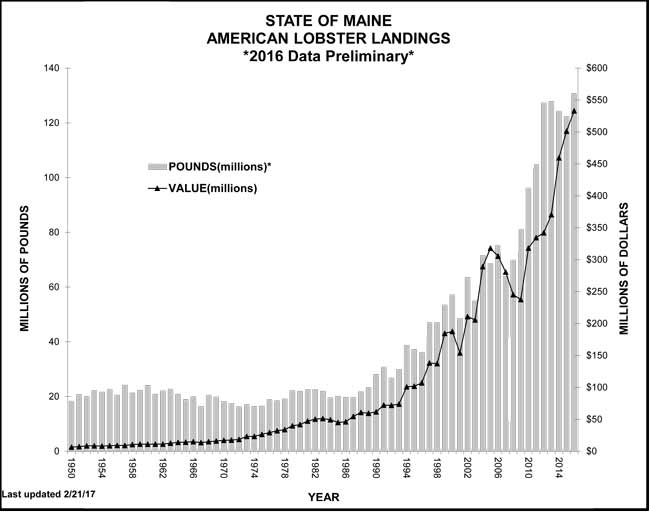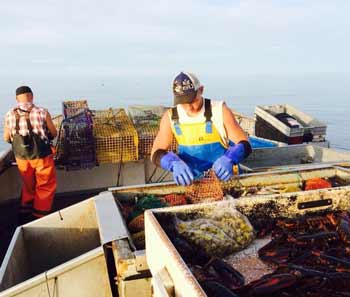Lobster Landings Surge, Settlement Declines
continued from April 2017 Homepage
“The big news is that our landings were up in 2016,” DMR Lead Lobster Biologist Kathleen Reardon said during a session on lobster science at the Maine Fishermen’s Forum in early March.

But continued findings around changes in the Gulf of Maine’s ecosystem continue to be a conversation among lobster scientists, she said.
For lobsters, the optimal temperature of seawater is 12 degrees Celsius, or 54-56 degrees Fahrenheit, she said. Greater than that starts to stress them out, she said. One study, off Boothbay, shows more days per year, since 2000, having sea surface temperature above the threshold than were seen in the previous hundred years.
“This is at the surface, not at the bottom, where the lobsters are,” she said. But it does contribute to the evidence that the Gulf of Maine is changing, she said.
With regard to landings, “We’ve been in a sweet spot” with optimal temperatures the last couple of years, she said.
Studies also show some regional differences. In western Maine, the water temperature at the bottom can be far colder than the surface water, whereas in eastern Maine, current mix the water more and there’s not as much temperature stratification.
The DMR has a number of surveys under way that look at the lobster’s various life stages, including young of the year, juveniles, and adults. But there’s no survey yet to study lobster larvae.
“There’s some thought that we should be looking at larvae, especially with temperatures changing at the surface,” Reardon said.
DMR biologist Robert Russell said the agency’s settlement index provides a first look at lobsters as they settle out. The survey began in 1989, in midcoast Maine, and expanded throughout the coast in 2000.
“The 12-degree threshold is an important number,” Russell said. Studies show that, above 12 degrees Celsius, lobsters molt faster and are larger each molt. Below 12 degrees, surveyors are seeing increased mortality, he said.
“The news is that we’re having another record year of landings,” said Russell. “But we had another low year on larval settlement. We’re on the third or fourth year of decline. The Gulf of Maine has changed, especially 2010 forward.”
The question is, he said, how does warmer water in deeper layers affect lobster settlement? And do the scientific models used to date to predict the status of the resource need to be changed?
“We need to figure out how we can change the predictive models and possibly alter the survey to adapt to the new environment we’re faced with,” he said. “The paradigm has changed. We need to address those concerns in order to get the best information to you guys.”
According to Maine Sea Grant, the settlement index came about in the 1980s as a result of a disconnect between what lobstermen were seeing at sea and what scientists were saying. The index was considered a new approach to marine ecology.
“Scientists began to recognize the importance of larval dynamics to the ‘supply-side’ of fish populations,” Sea Grant says. In 1987, Sea Grant provided funds to support development of a method to identify and quantify lobster nursery habitat. Using larval suction sampling, “researchers were able to show a link between larval settlement and recruitment of adult lobsters on the sea floor. Later, scientists found they could follow year classes through time, from the moment they settled on the bottom to their adult stage.”
In the years since, the index has expanded to over 60 sampling sites in other lobster producing regions in New England and Atlantic Canada. According to Sea Grant, “Data from the long-term monitoring has provided valuable insights into the pre- and post-settlement processes influencing lobster recruitment, as well as promising signs for a forecasting tool. The index has been included in the most recent federal stock assessments as an indicator of the health of the lobster resource.”

“What are the implications of deep-water settlement for the forecast?” To date, using the old model, he said, there has been good correlation between predictions and actual landings. ©Joel Woods photo
Rick Wahle, with the Darling Marine Center, helped start the index. He said researchers monitors regions from southern tip of New Brunswick to Rhode Island.
“We’re seeing a downward trend of some of the lowest settlement on record in 2016,” Wahle said. “When you hear of huge landings in Maine, it make you ask the question, where is the disconnect here? That is certainly going to be a question we’ll be focusing on the next few years.”
Wahle said an “expanding thermal habitat” might be causing young of the year to settle in broader and deeper areas.
“In the early years of the settlement index, we might have seen larvae settle into concentrated shallow zones, and that’s where we do our measuring,” he said. “It might be they’re settling over a much wider area now. This is one of the uncertainties of the settlement index. Are we missing part of the signal because they’re spreading out over broader areas and into deeper water?”
To address that question, he said, researchers first took advantage of a data set of modeled bottom temperatures over the entire Gulf of Maine, run by the University of Massachusetts/Dartmouth. That study shows that, for the lobster zones, the amount of bottom exposed to temperatures greater than 12 degrees Celsius is trending upward, especially in recent years.
“So we’re definitely seeing more bottom exposed to warmer temperatures,” he said.
A new project, in collaboration with Maine DMR and two fishermen, looks at deep-water settlement by deploying collectors across thermal and depth gradients from eastern to western Maine, he said.
“What are the implications of deep-water settlement for the forecast?” he said. To date, using the old model, he said, there has been good correlation between predictions and actual landings.
A new model that expands settlement over deeper water also falls well within the bounds of the previous model’s predictions, he said.
Nevertheless, he said, the models predict an eventual downturn in landings.
“Settlement is down again in 2016,” he said. “We still have to ask ourselves, why are we seeing this downturn in settlement when we’ve got higher egg production than we’ve ever seen before?” One reason, he said, might be the expanded settlement areas.
“But even with that, we’re seeing a projected downturn,” he said. “And we’re seeing higher larval mortality. And studies suggest we might be seeing higher mortality in the larval stages than we’ve seen before. So these projection models using the expanded thermal habitat are a bit more optimistic, but at the end of the day, we still project an eventual downturn. But we’re not talking about a collapse, so I don’t want to set off alarm bells or red flags.”
The cause of larval mortality is unclear, he said.
“There’s limited data sets on larvae,” he said.
Only one good set has been collected, off the New Hampshire coast in conjunction with impact studies of the Seabrook plant.
“They see first-stage larvae have been increasing, but the stage 4 numbers have been going down. That’s a significant trend,” he said. “It suggests there’s something going on between stage 1 and stage 4.”
Hypothetical scenarios include the possibility that there’s something different about the foods they’re eating, a change in predators, or changes in the physical oceanography driving the system.
“Right now, we don’t a have the smoking gun,” he said.
